Sharks have been around longer than trees (that’s a fact you’re just going to have to accept, because things get much stranger from here). Alongside other cartilaginous fishes like rays and chimaera, they sit within the ancient and successful clade known as Chondrichthyes, which has been enduring our planet’s ever-changing landscape for over 400 million years.
When you’ve been kicking around as long as that, you pick up a trick or two for survival, and a recent paper investigated two strange and likely rare reproductive strategies that may have helped them do it: parthenogenesis – aka, “virgin births” – and multiple embryos per eggcase (which we’ll shorten to MEPE, for ease). It’s possible that these unusual approaches to reproduction may improve an individual’s chance of success when mating opportunities are limited, but as for what those benefits are? Well, that sort of the question.
Compared to other vertebrates, the Chondrichthyes demonstrate unparalleled variation when it comes to how they make babies. Laying eggs, having live births, twins, and making babies “no male required” – it’s all groovy with the cartilaginous fish, and there’s even a shark in Australia that comes into the world attached to a placenta (and yes, that means sharks can have bellybuttons).

Behold, the alien egg of the Australian ghostshark (Callorhinchus milii).
Super eggs
It’s impressive to have maintained all these strategies while other animal groups have specialized down to just a few, but there are still some that are considered rarer among Chondrichthyes compared to others. They include MEPE, which in some extreme cases has seen as many as eight embryos packed into one egg case. Sounds pretty hectic, right? So what are the pros and cons?
Placing multiple embryos in a single egg case means the mother only needs to produce a single egg case.
Joel Harrison Gayford
“Hypothetically, a large number of embryos might increase the risk of death or delayed growth of the embryos if there is not enough space in the egg case for sufficient yolk, or if waste products begin to accumulate at a faster rate than they can be removed from the egg case,” said author Joel Harrison Gayford of James Cook University to IFLScience. “However, there are potential benefits.”
“Placing multiple embryos in a single egg case means the mother only needs to produce a single egg case. Even though these eggcases are typically larger than ‘normal’ eggcases, this still represents an energy saving that the mother could then invest in producing more embryos, or providing more nutrients via an enlarged or enhanced yolk sac.”
Gayford adds that we still don’t know exactly how beneficial or disadvantageous MEPE may be as a reproductive strategy, and that we need more data to fully unravel its mysteries. Still, a curious approach to breeding, as is our second point of focus: parthenogenesis.
Jesus sharks
This “no male required” approach to reproduction sees females doing it for themselves, creating offspring without the need for sexual reproduction. It’s been seen among over a dozen shark species and mostly in captivity because, for obvious reasons, it’s much easier to notice something unusual has happened when that all-female tank you’ve been waving at every day suddenly pops out a few mystery babies.
As demonstrated by those lone females, facultative parthenogenesis may be a way of overcoming a lack of access to mates. There have even been cases where female sharks had the option to mate with a male, but chose the DIY method anyway, so it could be that it sometimes occurs when the female decides their options just aren’t good enough.
We still don’t really know how rare parthenogenesis is among sharks, and it could be that it’s more common than we realize out in the wild. However, improving our understanding of the phenomenon could help us to better ensure these animals’ futures.
For endangered or threatened species, which many sharks and rays are, the number of offspring that individuals are able to produce is really important in shaping that species’ ability to bounce back from population declines.
Joel Harrison Gayford
“Parthenogenesis is important from a conservation perspective because it can potentially alter an individual’s lifetime fecundity, i.e. the number of offspring it has over the course of its lifespan,” explained Gayford. “For endangered or threatened species, which many sharks and rays are, the number of offspring that individuals are able to produce is really important in shaping that species’ ability to bounce back from population declines.”
“Across longer timespans, parthenogenesis also has more complex implications for the stability of populations, but given the dire conservation status of many sharks and rays, digging deeper into the potential role of reproductive biology in the protection and management of these charismatic species is crucial.”
The study is published in the journal Royal Society Open Science.
Source Link: Super Eggs, Jesus Sharks, And The Surprising Diversity Of Reproductive Strategies Among The Chondrichthyes